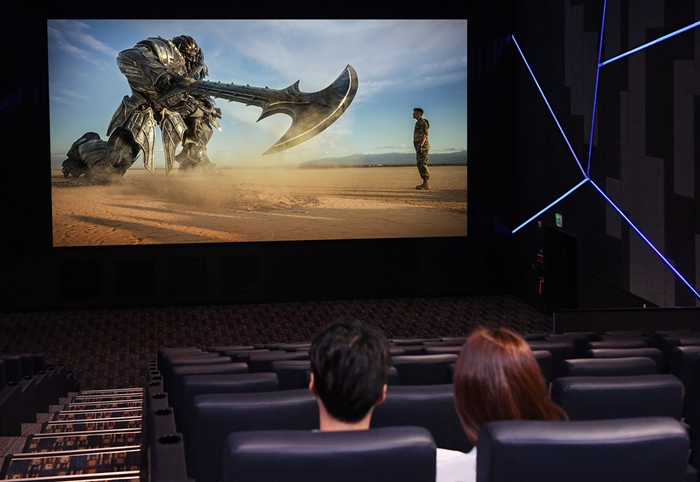
Samsung Electronics has introduced the world’s first LED screen for movie theaters, at the Lotte Cinema at Lotte World Tower in Jamsil, southeastern Seoul. (Samsung Electronics)
By Min Yea-Ji and Kim Young Shin
July 25, 2017 | Seoul
“I felt as if I was there at the port in Dunkirk. Under the pitch-black night sky, the soldiers escaped from a sinking destroyer, hit by a torpedo. At a regular theater, the scene would have been too dark and I would have had to assume what was happening from the sound. However, with this new screen, I was able to vividly see the grimaces of pain. When the emerald sea, where private boats were floating, and the blue sky, where the pilots were flying, met, a regular screen couldn't have been able to portray the difference in color. However, the subtle details were visible on the LED screen. It felt as if I was there in the evacuation. Although the 10.3-meter wide and 5.4-meter high screen seemed small compared to IMAX screens, the high quality of sound made up for it.”
That is the impression this writer had after watching a movie in a theater that featured the world’s first LED cinema screen, built by Samsung Electronics, at the Lotte Cinema at Lotte World Tower in southern Seoul.
The LED screen projects the movie directly onto the screen, rather than reflecting what’s beamed from a film projector. A current projector uses beams of light being shone at a screen, and light cannot be black. It can be misty gray at best. However, LED screens can be black. As the screen itself emits light, it can be as bright as 146 foot-lamberts, which is approximately 10 times brighter than current projecting methods. Also, its 4K (4096X2160) high definition display comes with “high dynamic range” technology, which maximizes realism by expressing depth with differentiating levels of brightness. This allows details to be seen in dark scenes.
“We commercialized the world’s first LED cinema screen that doesn't require a film projector,” said Kim Hyun-seok, the head of Samsung Electronics' Video Display Business Department. “I feel proud to be at the center of a major change of the history of cinema.”
Many audience members who saw a movie on the LED screen said that the screen was vivid compared to regular screens and that it felt "more real." However, some said that it made their eyes tired.
There are rosy prospects for LED screens thanks to their advantages, such as real black colors that are inexpressible with a film projector and a superior contrast range. However, there are pessimistic opinions, too, that it will just be a giant TV screen that shows a movie. The LED cinema screen today is at a crossroads.
jesimin@korea.kr